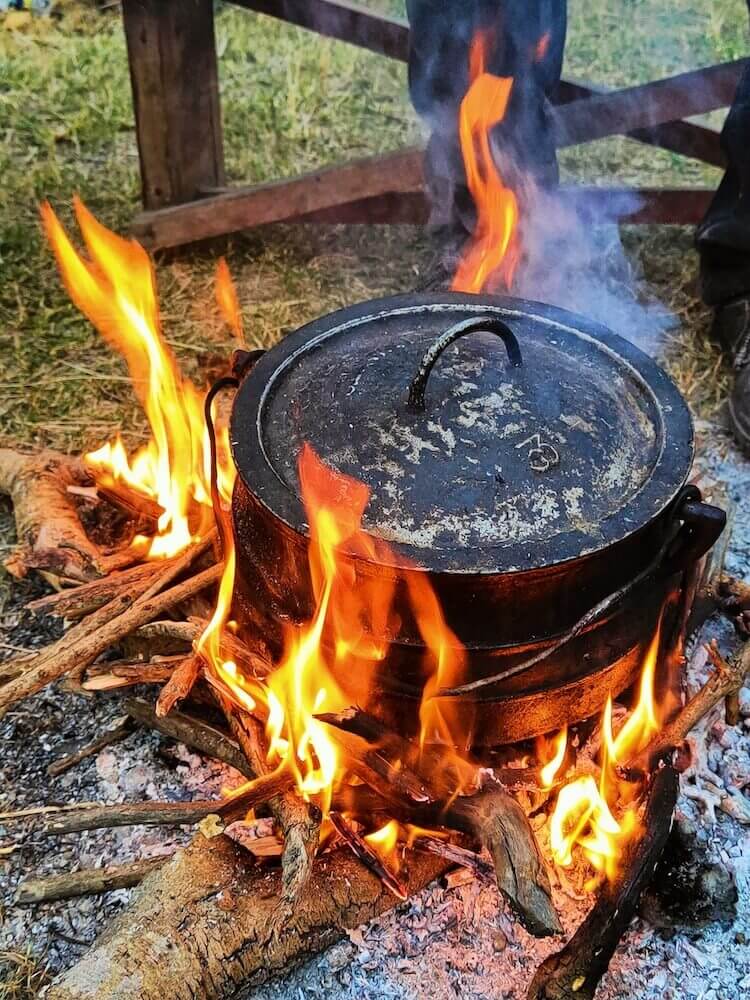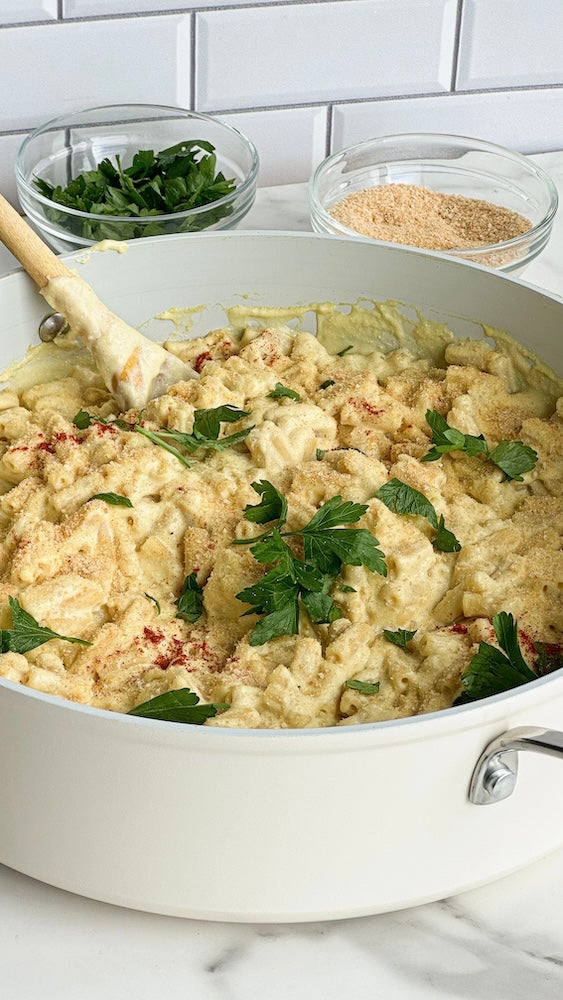Struggling To Decide Between The Clay Pot vs Dutch Oven? Let’s Find The Right Pick For You
I love a good stew, and nothing else goes well with stew than freshly baked bread. The best case scenario? Having them both made fresh at home!
Most would agree that the best stews and bread are typically made in a clay pot or a Dutch oven. But at some point in life, space and budget are luxuries that we just don’t have - which means we’ll have to choose between having one or the other.
So which is it going to be; the clay pot or a Dutch oven? That's a tough choice indeed.
With the clay pot and Dutch oven offering their own advantages alongside a touch of personality to the kitchen, we’re going to bring you on a little adventure to discover the right pot for you.
Whether it’s the clay pot vs Dutch oven, let’s explore both and help you discover your next beautiful kitchen companion!

Before We Go Into The Nitty-Gritties, Let’s Unearth A Few Things…For Starters, What Is A Clay Pot?
A clay pot is a traditional cooking vessel made from unglazed or glazed ceramic clay. It’s an age-old cookware that has been used for centuries across various cultures. Think the Moroccan tagine, the Balkan guvec, the Mexican cazuela, and the Chinese clay pot to name a few.
Clay pots are made by shaping clay into specific desired forms, then having it fired in a kiln at high temperatures to harden it. If you’re looking to only have organic cookware for your home, a clay pot is definitely your best bet.
One key characteristic of a clay pot is its porous nature, which you can very clearly feel through its textured surface especially when it is unglazed. This allows the clay pot to retain moisture within to keep food moist and flavoursome by circulating steam throughout the cooking process. Which also makes it ideal for slow and gentle cooking.

What Is A Dutch Oven?
If the cookware world had celebrities, the Dutch oven would undoubtedly be one of them. A Dutch oven is a heavy duty cooking pot that is typically made from cast iron or enameled cast iron, and comes with a tight-fitting lid - the heaviness and lid being its key characteristics.
That said, there are some Dutch ovens that are made from aluminium, stainless steel, or a combination of either metals with ceramic. These are oftentimes referred to as a casserole just like our stunning Cosmo Casserole pictured below and they come with different cooking advantages and maintenance needs.

For this article, we’ll be referring to cast iron Dutch ovens to avoid any confusion. Also for the fact that Dutch ovens are predominantly associated with cast iron in both casual and professional settings.
11 Factors To Consider Before Buying Clay Pots And Dutch Ovens
1. Material
Clay Pot
Clay pots are crafted from natural clay and it can be found in its unglazed or glazed form. This makes clay pots naturally environmentally-friendly because of its organic nature, making it the ideal choice for eco-warriors who prefer to keep their cookware green.
However, the very same material that makes it an eco-friendly option also makes it porous. Its porosity can be a good and a potentially bad thing. Good in the sense that it adds a unique flavour profile to your dishes, and bad when hygiene is in question.
Dutch Oven
Dutch ovens are primarily made from cast iron, making it an exceptionally durable yet heavy cookware with superior heat retention. Just like clay pots, bare cast iron Dutch ovens are also porous, which gives it the same flavour enhancing property like clay pots. However bare cast iron has one significant disadvantage in that long exposure to water will cause it to soak up the moisture and eventually rust.
The alternative to the usual cast iron Dutch ovens are the enameled cast iron Dutch ovens, which come with a protective vitreous enamel glaze applied on its surface. Enameled cast iron Dutch ovens are naturally resistant to rust, which makes it a much better choice in the battle between clay pots and Dutch ovens.
2. Heat Distribution
Clay Pot
The porous nature of clay allows it to slowly and evenly heat up, which makes it the ideal go-to for dishes that benefit from gentle cooking like slow cooking meats and stews. Its ability to evenly distribute heat helps food to cook evenly with little to no chance for hot spots.
Dutch Oven
Dutch ovens are the undisputed king of excellent heat retention and even heat distribution thanks to its thick cast iron construction. Because Dutch ovens retain heat excellently, this frees you to explore different cooking styles, including searing at high temperatures and slow cooking at low temperatures.

3. Cooking Versatility
Clay Pot
The humble clay pot is an excellent choice for dishes that require slow cooking, but its use is limited only to cooking methods that require low to medium heat exposure. That’s because the very nature of clay makes it vulnerable to the negative impact of sudden temperature changes (think cracks or shatters from thermal shock).
Which is why clay pots are typically associated with soups, braised dishes, and stews. Namely recipes that call for low and slow cooking.
Dutch Oven
A Dutch oven is a true workhorse in the kitchen thanks to its ability to withstand high temperatures. That allows you to practise and attempt various food cooking methods from frying and searing, to even baking bread! In a sense, it’s able to function much like an all-in-one versatile cookware piece both indoors and outdoors.
4. Flavour Preservation
Clay Pot
Remember how we mentioned earlier that the clay pot’s cooking surface is naturally porous? This very same characteristic allows it to enhance the moisture and flavour of the food.
A clay pot first preserves the flavours of the dish and in turn enhances it as a result of steam circulation through the minute pockets on its surface. By circulating steam throughout the cooking process, the dish’s nutritional value are retained so you’ll get more flavoursome and nutritious dishes.
Dutch Oven
Dutch ovens naturally come with tight-fitting lids which seal in the flavours and moisture of dishes cooked within. This makes it perfect for low and slow cooking just like the clay pot.
Having said that, Dutch ovens made from bare cast iron tend to naturally react with acidic ingredients, resulting in the impartation of slight metallic flavours which are non-toxic but undesirable to some. The said metallic flavour does come with an advantage of imparting a small dose of the iron mineral which our body needs - but again, this may be undesirable to some.
There are two ways to prevent metallic flavours from leaching onto your food, one of them being to avoid cooking acidic ingredients in a bare cast iron Dutch oven, and the other to cook it in an enameled Dutch oven instead. That’s because the enamel coating is not porous and will not react with acidic foods.
5. Cookware Maintenance
Clay Pot
Maintaining a clay pot feels like a mirror to what it offers. You get to enjoy gently low and slow cooked dishes out of it, but this also means that you’ll need to be gentle and careful with it.
Clay pots require special care such as regular seasoning sessions and careful cleaning with mild soap to maintain its integrity and cooking properties. I’m sure you’re now familiar with the porous nature of clay pots - this tends to cause very minute bits of food to remain if not properly scrubbed and it is prone to moisture buildup, which may cause mold to develop and impact hygiene in the long run.
Some clay pots also need to be wet before you can expose it to heat, just to avoid a situation where a cold clay pot is exposed a sudden temperature change, thus cracking in turn. Even with that, its natural characteristic as a clay-made cookware makes it more fragile compared to metal cookware.
Dutch Oven
Dutch ovens made from bare cast iron require regular seasoning to maintain a non-stick surface which also prevents it from rusting. So if you’ve ever seen mock-ups of seasoned chefs screaming in sheer horror when someone pops their cast iron cookware into the dishwasher or scrubs it vigorously by hand with soap, now you know why.
On the flipside, enameled Dutch ovens are much easier to maintain as they can often be cleaned with mild soap and water, with some even being dishwasher safe. And unless you purposely want to build a non-stick surface on your enameled Dutch oven, you don’t need to season it regularly.

6. Induction Cooktop Suitability
Clay Pot
You can cook in a clay pot on almost any heat source, except induction. That’s because clay pots do not contain any magnetic source within its construction to conduct heat through induction cooktops.
It’s also best to use clay pots only in ovens or on a stove top with a heat diffuser to avoid exposing it to direct heat, as clay pots break easily when exposed to sudden high heat. A safe alternative is to wet it before exposing it to direct heat.
The only slight exception are traditional Chinese clay pots bound in metal wires which aren’t commonplace. These are more durable against direct heat exposure, but even so they aren’t completely indestructible when exposed to direct heat.
Dutch Oven
On the other hand, Dutch ovens are exceptionally versatile when it comes to cooktop suitability. You can cook it on an electric hob, a gas stove top, induction cooktops, oven, outdoor grills, and expose it to open flames over a campfire!
The thick walls of the Dutch oven’s cast iron body makes it robust enough to be used almost anywhere, even outdoors. However, enameled Dutch ovens are not as robust and require far more care when it comes to outdoor cooking.
Just remember not to expose Dutch ovens to sudden changes in temperature like dousing a hot Dutch oven that has been exposed to high heat into a cold bath - it may cause the cookware to warp.
7. Health Concerns
Clay Pot
Because of the clay pot’s organic nature, I’d recommend sourcing clay cookware from reputable manufacturers to ensure that what you’re getting is a properly treated clay pot that is food-safe and lead-free.
Clay pots typically contain beneficial minerals that will be imparted into your food as you cook. But improperly treated or untreated clay pots may come with trace amounts of lead which may pose a health hazard in the long run.
Dutch Oven
Enameled Dutch ovens are naturally non-reactive and safe for cooking a wide range of foods, whereas bare cast iron can leach iron into food. It’s beneficial for some to consume that bit of iron, but this may be a concern for those who already have excess iron in their body.
To keep it safe and hassle-free, stick to enameled Dutch ovens which offer no chance of iron ever leaching onto your food over the cooking process (unless the enameled surface has already been cracked).
8. Which Is Dishwasher Safe?
Clay Pot
Under no circumstance should a clay pot ever be cleaned in a dishwasher. Clay pots are typically fragile in nature, so extra care must be taken to avoid damaging the surface. Once the surface is damaged, the clay pot will no longer have a place in your kitchen.
Clay pots typically require gentle hand washing and should never be subjected to harsh detergents and overly vigorous scrubbing with steel wool or any abrasive dishwashing sponges. Clean it gently and treat it with care to have a clay pot that will last for years in your kitchen.
Dutch Oven
Bare cast iron Dutch ovens require specific cleaning procedures to maintain the integrity of its cooking surface. For instance, you can’t subject it to harsh detergents and abrasive scrubs because those will ruin the natural non-stick developed over regular seasoning sessions.
The best way to clean a bare cast iron Dutch oven is to give it a light scrub with a natural coconut brush just to remove food remnants before seasoning it prior to storage.
If you’re not too keen on the multi-step process involved in caring for bare cast iron, then enameled Dutch ovens will be the best choice for you because they are generally dishwasher safe and far easier to clean.

9. Which Is Easier To Use?
Clay Pot
Clay pots are generally lighter than Dutch ovens, so those who struggle with lifting heavier objects will find that clay pots are much easier to handle. This comes in handy especially when you’re looking at lifting a cooking vessel filled with food, which adds to its existing weight.
But when it comes to cooking, clay pots tend to be more demanding in terms of finesse. Because clay pots are not suitable for high heat cooking techniques, you’ll have to maintain a watchful eye over the clay pot as it cooks so that the heat does not exceed your desired temperature. This includes placing your clay pot in a cold oven instead of a pre-heated one when it comes to oven cooking.
Clay cookers also requires more routine seasoning to enhance its natural non-stick properties and to prevent absorption of flavours and odours, and they need to be hand-washed and thoroughly dried to prevent mold from growing.
All in all this makes the clay pot a little more challenging to use especially for regular homecooks.
Dutch Oven
Dutch ovens along with its lid are naturally heavy so those with existing wrist injuries or homecooks who struggle with lifting heavy objects will find it a challenge to move it about. On the other side of the coin, this heaviness is a result of its durability, which means you won’t have to worry about damage from drops or knocks.
A Dutch oven’s naturally excellent heat retention and distribution also makes it incredibly user-friendly as you can get adventurous and try out various cooking methods. For instance, you can bake bread, sear steaks, simmer stews, and more - all with a single Dutch oven. Its ability to handle high heat also allows more flexibility when it comes to cooking.
However the ease of maintaining a Dutch oven depends on its material. Just like what we mentioned in #5 and #8, bare cast iron requires more labour when it comes to maintenance, but enameled Dutch ovens are easier to maintain thanks to its smooth, enamel-coated surface.
So after cooking with both a clay pot and a Dutch oven, I’m inclined to vouch that Dutch ovens are that much easier to handle between the two cookware.
10. Design And Aesthetics
Clay Pot
Whew, this is a tough competition between the clay pot vs Dutch oven! Clay pots carry a rustic charm that is a reflection of its handcrafted origin, adding a warm, organic touch to your home.
It comes in various designs, depending on the cultural background of the particular clay pot. For instance, you have the rich terracotta hues of Mediterranean clay pots, the rich and intricate patterns of the Moroccan tagine, and the simple, unadorned traditional style of Chinese clay pots.
Another fact is how clay pots are handmade, so no two clay pots are the same. If you find that you aren’t getting much use out of your clay pot, you can still use it as a decorative piece in your kitchen if space allows.
Dutch Oven
Dutch ovens on the other hand, come in only a few shapes and designs. These include the classic round shape, oval shape, and the occasional rectangle shaped Dutch oven. The design is typically sleek yet robust, with a focus on functionality and durability.
That said, certain brands manufacture enameled Dutch ovens in vibrant colours and glossy finishes, allowing you to choose a Dutch oven that resonates with your personal style and kitchen aesthetics.
While clay pots come in various designs unique to specific cultural backgrounds, Dutch ovens offer more versatility when it comes to a marriage of form and function.
11. Price
Clay Pot
Clay pots are generally more affordable because clay is an inexpensive material. Depending on the type of clay pot you’re after, the price of clay pots can range from mere dollars to hundreds.
More elaborate clay pots tend to bear a higher price tag that reflects its higher quality of craftsmanship, along with its country of origin. But you’ll find that clay pots are still more affordable than Dutch ovens even after all said and done.
Dutch Oven
The Dutch oven is often known as an investment piece in the cookware world. That’s because high quality Dutch ovens often get passed down to the next generation as a stunning heirloom piece. The high cost is also typically justified by their durability, versatility, and cooking performance.
Between A Clay Pot vs Dutch Oven, Which Is More Suitable For Me?
Choosing between a clay pot vs Dutch oven depends heavily on your cooking styles, cooking experience, design preferences, and the type of dishes you frequently prepare.
If you regularly cook dishes that require low and slow, gentle cooking, and you’re familiar with stringent temperature control when it comes to cooking, then I’d recommend equipping your kitchen with a clay pot.
But if you enjoy cooking tender and flavorful dishes, regularly entertain guests and you’re looking for a stunning piece to serve dishes from cooktop or oven to table, AND you want more versatility to explore various cuisines in the kitchen, then a Dutch oven is certainly a better bet.



